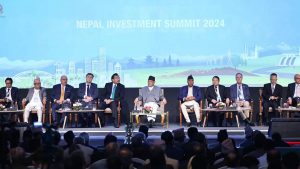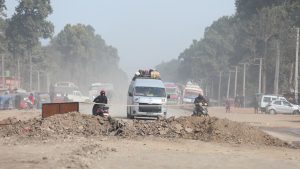
WB predicts improvement in Nepal’s economic growth in years ahead

The World Bank (WB) has projected an improvement in Nepal’s economic growth in the years ahead as the growth is expected to rebound to 3.9 percent in 2024 and 5 percent in the following year.
In the WB’s Nepal Development Update report launched today, the rise in the growth is expected due to impact of lifting import restrictions and the gradual loosening of monetary policy and so on.
However, inflation is expected to remain high, weighing on people’s real disposable incomes and private consumption.
Shedding light on the recent economic developments in Nepal, the WB states that real GDP growth decreased to an estimated 1.9 percent in 2023, the lowest rate since 2020 and substantially below the 10-year average growth rate. Likewise, monetary tightening and the effects of import restrictions contributed to the slowdown. Economic activity was particularly subdued in the industry and services sectors, while agricultural output remained more resilient.
Stating that slow credit growth and import restrictions contributed to a reduction in private investment on the demand side, it said lower capital expenditure and revenue underperformance drove lower public investment. “As a result, total investment decreased by more than 10 percent, a sharper reduction than in 2020. Private consumption remained robust, owing to strong remittance inflows.”
It is said inflation increased for the third successive year in 2023, and the increase was broad-based. Food prices rose due to supply side shocks and domestic policy changes. Non-food prices were pushed by higher housing and utility prices. The persistence of high inflation impedes an effective policy mix to stimulate growth while containing external imbalances.
Domestic policies and India’s trade restriction measures invoked a steep reduction of goods imports. Remittance inflows increased in 2023, following high outward migration in the previous year. Exports stagnated below their pre-pandemic level, caused also by a real appreciation due to Nepal’s persistently high inflation. Overall, the current account deficit decreased significantly, and the level of foreign currency reserves increased above its policy floor, according to the WB updates on Nepal development.
The contraction of imports caused a sharp decline in fiscal revenues, as more than half of total revenues are trade related. Because expenditures contracted at a much slower pace than revenues, the fiscal deficit nearly doubled to 6.1 percent of GDP, the highest deficit recorded in more than two decades. Overall, public debt increased due to the weaker fiscal performance to 41.3 percent of GDP, it is said.
Amid challenges, Nepal is leading the way towards operationalizing its green, resilient, and inclusive development vision to shape the country’s long-term economic recovery. Improved external competitiveness is key to driving this recovery and enabling Nepal to compete in export markets, in terms of both prices and quality. This requires emphasis on reforms to help increase domestic productivity and reduce the inflation differential with Nepal’s trading partners, the WB assessed.














Comments